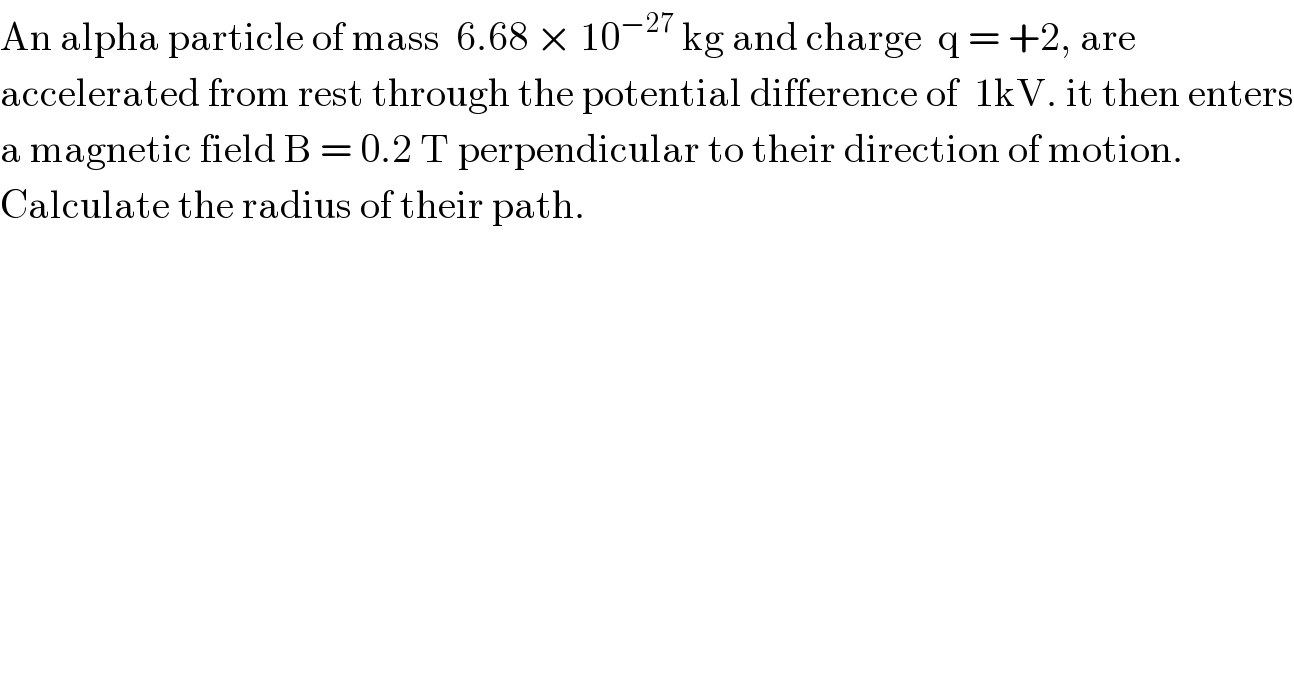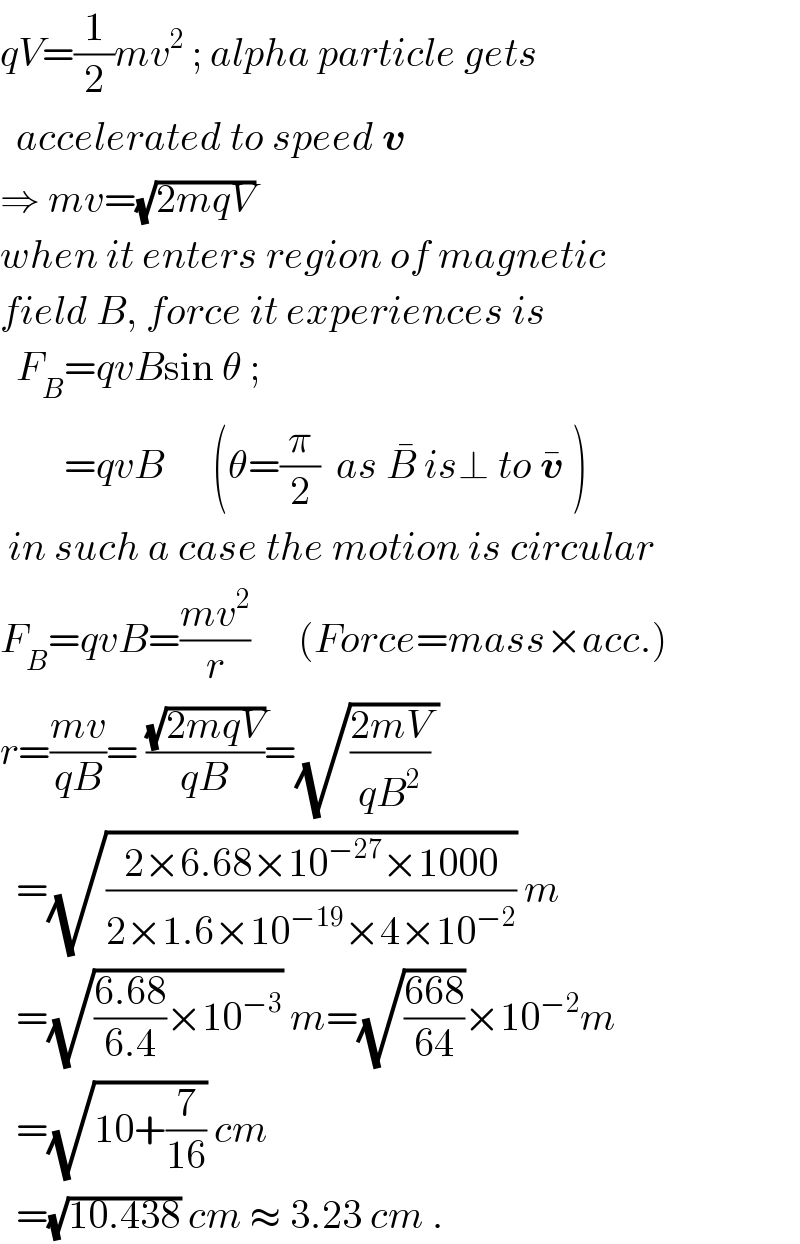Question Number 13872 by tawa tawa last updated on 24/May/17

$$\mathrm{An}\:\mathrm{alpha}\:\mathrm{particle}\:\mathrm{of}\:\mathrm{mass}\:\:\mathrm{6}.\mathrm{68}\:×\:\mathrm{10}^{−\mathrm{27}} \:\mathrm{kg}\:\mathrm{and}\:\mathrm{charge}\:\:\mathrm{q}\:=\:+\mathrm{2},\:\mathrm{are}\: \\ $$$$\mathrm{accelerated}\:\mathrm{from}\:\mathrm{rest}\:\mathrm{through}\:\mathrm{the}\:\mathrm{potential}\:\mathrm{difference}\:\mathrm{of}\:\:\mathrm{1kV}.\:\mathrm{it}\:\mathrm{then}\:\mathrm{enters} \\ $$$$\mathrm{a}\:\mathrm{magnetic}\:\mathrm{field}\:\mathrm{B}\:=\:\mathrm{0}.\mathrm{2}\:\mathrm{T}\:\mathrm{perpendicular}\:\mathrm{to}\:\mathrm{their}\:\mathrm{direction}\:\mathrm{of}\:\mathrm{motion}. \\ $$$$\mathrm{Calculate}\:\mathrm{the}\:\mathrm{radius}\:\mathrm{of}\:\mathrm{their}\:\mathrm{path}. \\ $$
Answered by ajfour last updated on 24/May/17

$${qV}=\frac{\mathrm{1}}{\mathrm{2}}{mv}^{\mathrm{2}} \:;\:{alpha}\:{particle}\:{gets} \\ $$$$\:\:{accelerated}\:{to}\:{speed}\:\boldsymbol{{v}}\: \\ $$$$\Rightarrow\:{mv}=\sqrt{\mathrm{2}{mqV}} \\ $$$${when}\:{it}\:{enters}\:{region}\:{of}\:{magnetic} \\ $$$${field}\:{B},\:{force}\:{it}\:{experiences}\:{is} \\ $$$$\:\:{F}_{{B}} ={qvB}\mathrm{sin}\:\theta\:;\: \\ $$$$\:\:\:\:\:\:\:\:={qvB}\:\:\:\:\:\:\left(\theta=\frac{\pi}{\mathrm{2}}\:\:{as}\:\bar {{B}}\:{is}\bot\:{to}\:\bar {\boldsymbol{{v}}}\:\right) \\ $$$$\:{in}\:{such}\:{a}\:{case}\:{the}\:{motion}\:{is}\:{circular} \\ $$$${F}_{{B}} ={qvB}=\frac{{mv}^{\mathrm{2}} }{{r}}\:\:\:\:\:\:\left({Force}={mass}×{acc}.\right) \\ $$$${r}=\frac{{mv}}{{qB}}=\:\frac{\sqrt{\mathrm{2}{mqV}}}{{qB}}=\sqrt{\frac{\mathrm{2}{mV}}{{qB}^{\mathrm{2}} }\:} \\ $$$$\:\:=\sqrt{\frac{\mathrm{2}×\mathrm{6}.\mathrm{68}×\mathrm{10}^{−\mathrm{27}} ×\mathrm{1000}}{\mathrm{2}×\mathrm{1}.\mathrm{6}×\mathrm{10}^{−\mathrm{19}} ×\mathrm{4}×\mathrm{10}^{−\mathrm{2}} }}\:{m} \\ $$$$\:\:=\sqrt{\frac{\mathrm{6}.\mathrm{68}}{\mathrm{6}.\mathrm{4}}×\mathrm{10}^{−\mathrm{3}} }\:{m}=\sqrt{\frac{\mathrm{668}}{\mathrm{64}}}×\mathrm{10}^{−\mathrm{2}} {m} \\ $$$$\:\:=\sqrt{\mathrm{10}+\frac{\mathrm{7}}{\mathrm{16}}}\:{cm} \\ $$$$\:\:=\sqrt{\mathrm{10}.\mathrm{438}}\:{cm}\:\approx\:\mathrm{3}.\mathrm{23}\:{cm}\:. \\ $$
Commented by tawa tawa last updated on 24/May/17

$$\mathrm{God}\:\mathrm{bless}\:\mathrm{you}\:\mathrm{sir}.\:\mathrm{I}\:\mathrm{really}\:\mathrm{appreciate}. \\ $$
